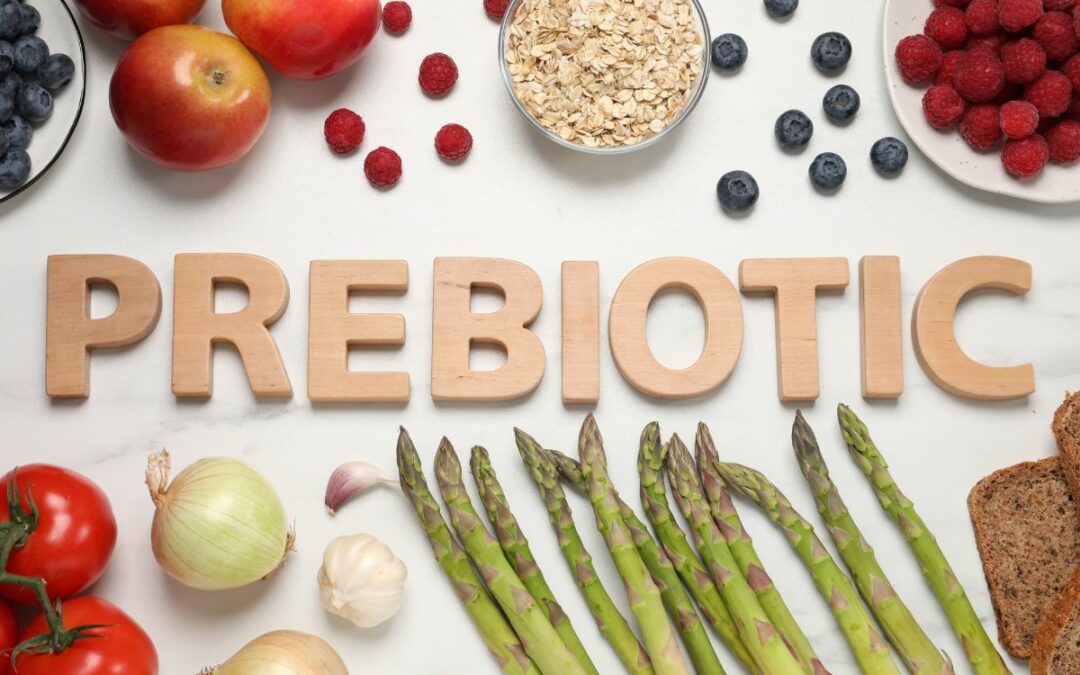If you want to live a vibrant and healthy life, more and more research is discovering that focusing on your gut health is key.
You gut is home to trillions of friendly microbes, known as your microbiome or probiotics. These microbes do more than help you break down your food. They also produce nutrients, neutralize toxins, act as a frontline defense against pathogens, and keep inflammation in check, reducing the risk of chronic diseases like diabetes and heart issues (1). And that’s not all.
They also help produce neurotransmitters (fancy brain chemicals) that affect your mood. So, a happy gut clearly = better digestion, improved immunity and a happier healthier you.
By now you may already know that it’s good for your gut to eat probiotic rich foods and taking high quality probiotic supplements daily. But prebiotics are key too.
But what are prebiotics? And why are they so important for our health?
In this blog post, we’ll talk about the importance of prebiotics for health and name the top 29 prebiotic-rich foods to transform your gut health. Finally, we’ll give you easy ways to increase your prebiotic intake so you can boost the health of your gut’s microbiome.
First: What are Prebiotic Foods?
Prebiotic foods are foods that contain non-digestible fibers that serve as a food source for the beneficial bacteria residing in our digestive system (2).
Unlike probiotics, which are the strains of live bacteria, prebiotics are the indigestible fibers that nourish and promote the growth of these friendly microbes. They’re essentially snacks for the probiotics.
By incorporating these fiber-rich foods into our daily diet, we can create an environment in our gut that feeds our microbiome and promotes overall health.
Here are the top 29 prebiotic foods that you can easily find and enjoy:
1. Chicory Root
This plant is a rich source of inulin, a type of prebiotic fiber that stimulates the growth of bifidobacteria, a beneficial strain of bacteria in the gut.
Chicory root has anti-inflammatory, antioxidant and blood-balancing properties and can also help regulate appetite, and boost the immune system (3).
You can use chicory root as a coffee substitute or add it to salads and soups.
2. Jerusalem Artichokes
Also known as sunchokes, these tubers are high in inulin, a type of indigestible fiber and other prebiotic fibers that probiotics love.
They can help improve digestion, lower blood sugar levels, and boost immunity (4).
You can eat them raw in salads or roast, boil, or mash them like potatoes.
3. Onions
Onions are one of the most common and versatile prebiotic foods. They contain fructooligosaccharides (FOS), a type of prebiotic fiber that feeds the beneficial bacteria in the gut (5).
Onions also have anti-inflammatory, antibacterial, and anticancer effects (6).
You can add them to almost any savory dish, from soups and stews to stir-fries, omelettes, and salads.
4. Garlic
Garlic is another prebiotic powerhouse that contains FOS and other beneficial compounds (7).
Garlic can help fight infections, lower blood pressure, and improve cholesterol levels (8).
It also adds a lot of flavor to your dishes. You can use fresh or roasted garlic in sauces, dips, dressings, or marinades.
5. Bananas
Bananas are a delicious and easy way to get some prebiotics into your diet. They contain resistant starch and pectin, two types of prebiotic fibers that support the growth of good bacteria in the gut.
Bananas also have potassium, magnesium, and vitamin C (9).
You can eat them as a snack, add them to smoothies or oatmeal, or bake them into breads or muffins.
6. Asparagus
Asparagus is a spring vegetable that is rich in inulin and other prebiotic fibers.
Asparagus can help improve digestion, regulate blood sugar levels, and prevent urinary tract infections (10).
You can steam, roast, or grill asparagus and serve it as a side dish or salad ingredient.
7. Leeks
Leeks are related to onions and garlic and have similar prebiotic benefits.
They contain FOS and other prebiotic fibers that feed the good bacteria in the gut. Leeks also have vitamin K, folate, and manganese (11).
You can use leeks in soups, quiches, pies, or casseroles.
8. Dandelion Greens
Dandelion greens are edible weeds that are surprisingly nutritious and prebiotic. They contain inulin and other prebiotic fibers that stimulate the growth of bifidobacteria in the gut.
Dandelion greens also have vitamin A, vitamin C, calcium, and iron (12).
You can add them to salads, smoothies, or teas.
9. Oats
Oats are a staple breakfast food that are high in beta-glucan, a type of prebiotic fiber that lowers cholesterol levels, improves blood sugar control, and boosts immunity.
Oats also have protein, antioxidants, and minerals (13).
You can make oatmeal, granola, or overnight oats with oats and enjoy them with fruits, nuts, or seeds.
10. Apples
Apples are a crunchy and sweet fruit that are rich in pectin, a type of prebiotic fiber that supports the growth of good bacteria in the gut.
Apples also have quercetin, a flavonoid that has anti-inflammatory and antihistamine effects (14).
You can eat apples raw, cooked, or dried, or make apple sauce, cider, or pie with them.
11. Cocoa
Cocoa is the raw form of chocolate that is loaded with prebiotics and antioxidants. Cocoa contains polyphenols, a type of plant compound that can modulate the gut microbiota and reduce inflammation (15).
Cocoa also has magnesium, iron, and zinc.
You can use cocoa powder in smoothies, hot chocolate, or baked goods, or eat dark chocolate with a high percentage of cocoa content for the most benefits.
12. Flaxseeds
Flaxseeds are tiny seeds that are packed with prebiotics and omega-3 fatty acids. Flaxseeds contain soluble and insoluble fibers that can improve digestion, lower cholesterol levels, and balance hormones (16).
Flaxseeds also have lignans, a type of phytoestrogen that can protect against certain cancers.
You can grind flaxseeds and add them to smoothies, oatmeal, or baked goods, or use flaxseed oil in salads or dressings.
13. Berries
Berries are a group of colorful and sweet fruits that are high in prebiotics and antioxidants (17). Some of the best berries for your gut health are blueberries, raspberries, strawberries, and cranberries.
These berries contain pectin and other prebiotic fibers that can feed the good bacteria in the gut and produce SCFAs, which are beneficial compounds that can lower inflammation, improve immunity, and protect against colon cancer (18).
These berries also have polyphenols, a type of plant compound that can modulate the gut microbiota and reduce inflammation (19).
Berries are a delicious and easy way to get some prebiotics into your diet. You can eat them raw, cooked, or dried, or use them in salads, smoothies, jams, pies, or muffins.
14. Barley
Barley is a cereal grain that is high in beta-glucan and other prebiotic fibers. Barley can help lower blood sugar levels, reduce appetite, and prevent constipation (20).
Barley also has protein, B vitamins, and minerals including iron, potassium, zinc and phosphorous (21).
You can use barley in soups, stews, salads, or risottos. You can also make barley water or tea with it.
15. Wheat Bran
Wheat bran is the outer layer of the wheat kernel that is rich in prebiotics and antioxidants.
Wheat bran contains arabinoxylan, a type of prebiotic fiber that can increase the production of short-chain fatty acids (SCFAs) in the gut (22). SCFAs are beneficial compounds that can lower inflammation, improve immunity, and protect against colon cancer (23).
You can add wheat bran to cereals, muffins, or breads, or use it as a coating for chicken or fish.
16. Legumes and Beans
Legumes and beans are a great source of prebiotics and protein. They contain resistant starch and other prebiotic fibers that can feed the good bacteria in the gut and produce SCFAs (24).
Legumes and beans also have nutrients like iron, folate, and phytochemicals (25).
You can eat them as a main or side dish, or use them in soups, salads, dips, or burgers.
17. Jicama
Jicama is a root vegetable that is crunchy and refreshing. It is high in inulin and other prebiotic fibers that can boost the growth of bifidobacteria in the gut (26).
Jicama also has vitamin C, potassium, and calcium (27).
You can peel and slice jicama and eat it raw, or add it to salads, slaws, or salsas.
18. Seaweed
Seaweed is a type of edible algae that is rich in prebiotics and minerals. Seaweed contains alginate, a type of prebiotic fiber that can increase the diversity of the gut microbiota and reduce fat absorption (28).
With antioxidant, antibacterial and anticancer properties, seaweed also has protein, iodine, magnesium, and iron (29).
You can eat seaweed as a snack, or use it in soups, salads, or sushi.
19. Cabbage
Cabbage is a cruciferous vegetable that is high in prebiotics and antioxidants. Cabbage contains glucosinolates, a type of plant compound that can modulate the gut microbiota and prevent cancer (30).
Cabbage also has vitamin C, vitamin E, vitamin K, and folate.
You can eat cabbage raw, cooked, or fermented, or use it in coleslaw, sauerkraut, or kimchi.
20. Carrots
Carrots are a root vegetable that are high in pectin and other prebiotic fibers that can support the growth of good bacteria in the gut (31). Carrots can also help lower cholesterol,
Carrots also have vitamin A (β-Carotene), vitamin K, and biotin.
You can eat carrots raw, cooked, or juiced, or use them in soups, salads, muffins or cakes.
21. Radishes
Radishes are a spicy and crunchy vegetable that are high in prebiotics and antioxidants. Both the edible greens and the roots of radishes contain FOS and other prebiotic fibers that can stimulate the growth of bifidobacteria in the gut (32).
Radishes also have vitamin C, potassium, and manganese (33).
You can eat radishes raw, cooked, or pickled, or use them in salads, dips, or sandwiches.
22. Burdock Root
Burdock root is a anti-inflammatory medicinal herb that is high in prebiotics and antioxidants. Burdock root contains inulin and other prebiotic fibers that can improve digestion, detoxify the liver, and balance blood sugar levels (34).
Not only does it promote detoxification in the body, but urdock root is also a good source of vitamin B6, magnesium, and phosphorus (35).
You can use burdock root in teas, soups, or stir-fries, or eat it raw or pickled.
23. Konjac Root
Konjac root is a plant that is high in glucomannan, a type of prebiotic fiber that can absorb water and form a gel-like substance in the gut (36).
Konjac root can help lower cholesterol levels, regulate blood sugar levels, and promote weight loss (37).
Konjac root is also used to make shirataki noodles, a low-calorie, low-carb and gluten-free alternative to pasta. You can use shirataki noodles in soups, salads, or stir-fries, or make desserts with them.
24. Lima Beans
Lima beans are a type of legume that are high in prebiotics and protein. Lima beans contain resistant starch and other prebiotic fibers that can feed the good bacteria in the gut and produce SCFAs (38).
Lima beans also have iron, folate, and potassium.
You can cook lima beans and eat them as a main or side dish, or use them in soups, salads, or dips.
25. Mung Beans
Mung beans are another type of legume that are high in prebiotics and protein. Mung beans contain resistant starch and other prebiotic fibers that can support the growth of good bacteria in the gut and produce SCFAs (39).
Mung beans also have vitamins C and K, as well as manganese (40).
You can sprout mung beans and eat them raw, or cook them and use them in soups, salads, or curries.
26. Almonds and Hazelnuts
Almonds and hazelnuts are nuts that are high in prebiotics and healthy fats. Almonds and hazelnuts contain FOS and other prebiotic fibers that can stimulate the growth of bifidobacteria in the gut (40, 41).
Almonds and hazelnuts also have nutrients like vitamin E, magnesium, and calcium (42).
You can eat them as a snack, add them to granola or trail mix, or use them in baked goods or nut butters.
27. Guava
Guava is a tropical fruit that is high in prebiotics and vitamin C. Guava contains pectin and other prebiotic fibers that can support the growth of good bacteria in the gut (43).
Guava also has lycopene, a carotenoid that has antioxidant and anti-inflammatory effects (44).
You can eat guava raw, cooked, or juiced, or use it in jams, sauces, or desserts.
28. Pears
Pears are a juicy and sweet fruit that are high in prebiotics and antioxidants. Pears contain pectin and other prebiotic fibers that can feed the good bacteria in the gut and produce SCFAs (45).
Pears also have vitamin C, vitamin K, and copper.
You can eat pears raw, cooked, or dried, or use them in salads, pies, or smoothies.
29. Kiwi
Kiwi is a fuzzy and tangy fruit that is high in prebiotics and vitamin C. Kiwi contains actinidin, a type of enzyme that can enhance the digestion of proteins and the absorption of nutrients (46).
Kiwi also has vitamin K, folate, and potassium (47).
You can eat kiwi raw, cooked, or juiced, or use it in salads, salsas, or desserts.
Understanding Prebiotics in Depth
Now that we have explored the top 29 prebiotic foods, let’s delve deeper into prebiotics and their role in our health.
What are prebiotics? How do they benefit us? And how can we optimize our prebiotic intake?
What are Prebiotics?
Prebiotics are non-digestible fibers that serve as a food source for the beneficial bacteria residing in our digestive system. Unlike probiotics, which are strains of live bacteria and beneficial yeasts, prebiotics are the indigestible fibers that nourish and promote the growth of these friendly microbes.
Prebiotics can be found naturally in many plant-based foods, such as fruits, vegetables, grains, legumes, nuts, and seeds. They can also be added to foods or supplements as functional ingredients.
These are the Health Benefits of Prebiotics
The benefits of incorporating prebiotics into our diet extend beyond gut health. They play a crucial role in supporting our immune system, improving digestion, and even influencing mental health.
The main health benefits of prebiotics are:
- Improved Gut Health: Prebiotics can help maintain a balanced and diverse gut microbiome, which is the community of bacteria and other microorganisms that live in our digestive system. A healthy gut microbiome can improve digestion, absorption of nutrients, and protection against pathogens. Prebiotics can also increase the production of SCFAs, which are beneficial compounds that can lower inflammation, improve immunity, and protect against colon cancer (48).
- Enhanced Immune System: Prebiotics can help boost our immune system by modulating the gut microbiome and increasing the production of SCFAs. A healthy gut microbiome can enhance the function of immune cells, such as natural killer cells, macrophages, and T cells. SCFAs can also regulate the expression of genes involved in immune responses, such as cytokines, chemokines, and toll-like receptors (49).
- Better Digestion: Prebiotics can help improve digestion by increasing the activity and diversity of the gut microbiome and the production of SCFAs. A healthy gut microbiome can help break down complex carbohydrates, synthesize vitamins, and prevent the growth of harmful bacteria. SCFAs can also help maintain the integrity of the intestinal lining, prevent leaky gut syndrome, and stimulate intestinal motility (50).
- Lower Blood Sugar Levels: Prebiotics can help lower blood sugar levels by modulating the gut microbiome and increasing the production of SCFAs (51). A healthy gut microbiome can help regulate glucose metabolism, insulin sensitivity, and inflammation. SCFAs can also help suppress appetite, reduce fat storage, and increase energy expenditure (52).
- Improved Cholesterol Levels: Prebiotics can help improve cholesterol levels by modulating the gut microbiome and increasing the production of SCFAs. A healthy gut microbiome can help lower the absorption of dietary cholesterol, increase the excretion of bile acids, and reduce the synthesis of cholesterol in the liver (53). SCFAs can also help lower the levels of LDL (bad) cholesterol and triglycerides, and increase the levels of HDL (good) cholesterol (54).
- Enhanced Mental Health: Prebiotics can help enhance mental health by modulating the gut microbiome and increasing the production of SCFAs. A healthy gut microbiome can help produce and regulate neurotransmitters, such as serotonin, dopamine, and GABA, which are involved in mood, cognition, and behavior (55). SCFAs can also help cross the blood-brain barrier and influence brain function, such as learning, memory, and neurogenesis (56).
Foods Rich in Prebiotics
As we have seen, prebiotics are abundant in many plant-based foods, such as fruits, vegetables, grains, legumes, nuts, and seeds.
However, not all prebiotic foods are created equal. Some foods contain more prebiotic fibers than others, and some prebiotic fibers are more effective than others.
Here are some of the most common types of prebiotic fibers and the foods that contain them (57, 58):
- Inulin: Inulin is a type of prebiotic fiber that belongs to the fructan family. It is composed of chains of fructose molecules that are linked by beta bonds, which make them resistant to digestion. Inulin can stimulate the growth of bifidobacteria, a beneficial strain of bacteria in the gut. Inulin can also increase the production of SCFAs, especially butyrate, which is the preferred fuel for the colon cells. Foods that are high in inulin include chicory root, Jerusalem artichokes, onions, garlic, asparagus, leeks, dandelion greens, jicama, and burdock root.
- Fructooligosaccharides (FOS): FOS are a type of prebiotic fiber that also belong to the fructan family. They are composed of shorter chains of fructose molecules that are linked by beta bonds. FOS can also stimulate the growth of bifidobacteria and increase the production of SCFAs. Foods that are high in FOS include onions, garlic, leeks, radishes, bananas, and almonds and hazelnuts.
- Galactooligosaccharides (GOS): GOS are a type of prebiotic fiber that belong to the galactan family. They are composed of chains of galactose molecules that are linked by beta bonds. GOS can stimulate the growth of bifidobacteria and lactobacilli, two beneficial strains of bacteria in the gut. GOS can also increase the production of SCFAs and modulate the immune system. Foods that are high in GOS include legumes and beans, such as lima beans, mung beans, lentils, chickpeas, and soybeans.
- Resistant Starch: Resistant starch is a type of prebiotic fiber that belongs to the starch family. It is composed of chains of glucose molecules that are linked by alpha bonds, but are resistant to digestion by the enzymes in the small intestine. Resistant starch can stimulate the growth of various beneficial bacteria in the gut and increase the production of SCFAs. Foods that are high in resistant starch include green bananas, oats, barley, wheat bran, legumes and beans, cooked and cooled potatoes, rice, and pasta.
- Pectin: Pectin is a type of prebiotic fiber that belongs to the pectin family. It is composed of chains of galacturonic acid molecules that are linked by alpha bonds. Pectin can support the growth of good bacteria in the gut and increase the production of SCFAs. Pectin can also lower cholesterol levels, regulate blood sugar levels, and prevent diarrhea. Foods that are high in pectin include apples, pears, guava, kiwi, citrus fruits, berries, and carrots.
- Beta-Glucan: Beta-glucan is a type of prebiotic fiber that belongs to the beta-glucan family. It is composed of chains of glucose molecules that are linked by beta bonds. Beta-glucan can lower cholesterol levels, improve blood sugar control, and boost immunity. Beta-glucan can also modulate the gut microbiota and increase the production of SCFAs. Foods that are high in beta-glucan include oats, barley, wheat bran, mushrooms, and seaweed.
- Polyphenols: Polyphenols are a type of plant compound that have antioxidant and anti-inflammatory effects. Polyphenols can also modulate the gut microbiota and increase the production of SCFAs. Polyphenols can help prevent oxidative stress, inflammation, and chronic diseases, such as cardiovascular disease, diabetes, and cancer. Foods that are high in polyphenols include cocoa, dark chocolate, berries, grapes, red wine, tea, coffee, and spices.
Enhancing Your Prebiotic Intake
Now that we have a deeper understanding of prebiotics and their role in our health, let’s explore practical ways to increase our prebiotic intake and enhance our gut microbiome. How can we incorporate more prebiotic foods into our diet? And how can we optimize the synergy of prebiotics, probiotics, and postbiotics?
How to Increase Your Prebiotic Intake
Incorporating prebiotic-rich foods into our diet is not as difficult as it may seem. There are many delicious and easy ways to enjoy these foods and reap their benefits.
Here are 3 tips for increasing your prebiotic intake:
- Diversify Your Plate: Include a variety of prebiotic-rich foods in your meals to ensure a broad spectrum of nutrients for your gut microbes. Aim for at least 5 servings of fruits and vegetables per day, and choose different colors, shapes, and textures. Also, include whole grains, legumes, nuts, and seeds in your diet, and experiment with different cuisines and flavors.
- Cook and Eat Mindfully: Cooking methods can affect the prebiotic content of foods. Aim for minimal processing to retain their beneficial fibers. For example, avoid peeling, overcooking, or juicing fruits and vegetables, as these can reduce their prebiotic content. Instead, eat them whole, raw, or lightly cooked, and enjoy their skins, seeds, and cores. Also, be mindful of how you eat. Chew your food well, savor the taste, and pay attention to your hunger and fullness cues. This can help improve your digestion and absorption of prebiotics.
- Combine Prebiotics with Probiotics: While prebiotics lay the foundation, the synergy of probiotics and postbiotics completes the holistic approach to gut health. Probiotic-rich foods, such as yogurt and fermented foods, complement prebiotics by introducing live beneficial bacteria into the gut. Postbiotic-rich foods, such as vinegar and cheese, complement prebiotics by providing metabolic byproducts of bacterial fermentation, such as SCFAs. By combining prebiotics with probiotics and postbiotics, you can create a symbiotic relationship that enhances the effectiveness of each component. For example, you can make a parfait with yogurt, granola, and berries, or a salad with cheese, nuts, and vinegar dressing.
The Distinction: Prebiotics vs. Probiotics vs. Postbiotics
Understanding the differences between prebiotics, probiotics, and postbiotics is crucial for tailoring our approach to gut health. Each component contributes uniquely to maintaining a harmonious gut microbiome.
Here’s a summary of the main distinctions:
Prebiotics
Prebiotics are non-digestible fibers that serve as a food source for the beneficial bacteria in the gut. They can be found naturally in many plant-based foods, such as fruits, vegetables, grains, legumes, nuts, and seeds.
They can also be added to foods or supplements as functional ingredients. Prebiotics can help improve gut health, immune system, digestion, blood sugar levels, cholesterol levels, and mental health.
Probiotics
Probiotics are live bacteria that can colonize the gut and confer health benefits. They can be found naturally in fermented foods, such as yogurt, kefir, sauerkraut, kimchi, miso, tempeh, and kombucha.
They can also be added to foods or supplements as functional ingredients. Probiotics can help improve gut health, immune system, digestion, mood, cognition, and behavior (59).
Postbiotics
Postbiotics are metabolic byproducts of bacterial fermentation that can exert health effects. They can be found naturally in foods that contain prebiotics or probiotics, such as vinegar, cheese, sourdough bread, and wine.
They can also be added to foods or supplements as functional ingredients.
Postbiotics can help improve gut health, immune system, inflammation, and brain function (60).
Benefits of Consuming Probiotics Alongside Prebiotics
The combination of prebiotics and probiotics creates a symbiotic relationship that enhances the effectiveness of each. Probiotics, being live bacteria, thrive on the nourishment provided by prebiotics, leading to a more robust and resilient gut environment.
Prebiotics, being non-digestible fibers, benefit from the fermentation activity of probiotics, leading to a more diverse and balanced gut microbiome.
Here are some of the benefits of consuming probiotics alongside prebiotics:
- Increased Survival and Colonization of Probiotics: Prebiotics can help increase the survival and colonization of probiotics in the gut by providing them with a suitable pH, temperature, and substrate. Prebiotics can also help protect probiotics from the harsh conditions of the stomach and the small intestine, such as acidity, bile, and enzymes. This can enhance the viability and efficacy of probiotics in the gut.
- Increased Production and Utilization of SCFAs: Prebiotics can help increase the production and utilization of SCFAs in the gut by providing them with a substrate for fermentation. SCFAs are beneficial compounds that can lower inflammation, improve immunity, and protect against colon cancer. Probiotics can help increase the production and utilization of SCFAs in the gut by producing enzymes that can break down prebiotics into SCFAs. Probiotics can also help utilize SCFAs as an energy source, leading to a more efficient and sustainable gut ecosystem.
- Increased Diversity and Stability of the Gut Microbiome: Prebiotics can help increase the diversity and stability of the gut microbiome by providing a food source for a wide range of beneficial bacteria. Prebiotics can also help prevent the overgrowth of harmful bacteria by creating a competitive environment in the gut. Probiotics can help increase the diversity and stability of the gut microbiome by introducing new strains of beneficial bacteria into the gut. Probiotics can also help prevent the loss of beneficial bacteria due to antibiotics, stress, or illness.
FAQs About Prebiotics
As we navigate the world of gut health, it’s natural to have questions. Let’s address some common queries to deepen our understanding of prebiotics and their role in our well-being.
- Q: How much prebiotics do I need per day?
- A: The optimal amount of prebiotics per day may vary depending on your age, health status, and personal preference. However, a general recommendation is to consume at least 5 grams of prebiotics per day (based on a 2000 kcal/day diet) (61). This can be achieved by eating 2-3 servings of prebiotic-rich foods. You can also supplement your diet with prebiotic products, such as powders, capsules, or gummies, but make sure to consult your doctor before taking any supplements.
- Q: Are there any side effects of prebiotics?
- A: Prebiotics are generally safe and well-tolerated by most people. However, some people may experience some mild side effects, such as bloating, gas, cramps, or diarrhea, especially if they consume too much prebiotics or are not used to them. These side effects are usually temporary and subside as the gut adapts to the increased prebiotic intake (62). To minimize these side effects, it is advisable to start with a low dose of prebiotics and gradually increase it over time. It is also important to drink plenty of water and eat a balanced diet that includes probiotics and postbiotics.
- Q: Can I get prebiotics from animal sources?
- A: Prebiotics are mainly found in plant-based foods, such as fruits, vegetables, grains, legumes, nuts, and seeds. However, some animal sources may also contain small amounts of prebiotics, such as honey, colostrum, chitin (the exoskeletons of insects and crustaceans) and human breast milk. These animal sources may have other health benefits, such as antibacterial, anti-inflammatory, and immunomodulatory effects, but they are not as rich or diverse in prebiotics as plant sources.
- Q: How do prebiotics affect weight loss?
- A: Prebiotics may help with weight loss by modulating the gut microbiome and increasing the production of SCFAs. A healthy gut microbiome can help regulate appetite, metabolism, and inflammation, which are all factors that affect weight management. SCFAs can also help suppress hunger, reduce fat storage, and increase energy expenditure, which can lead to a lower body weight (63). However, prebiotics alone are not enough to achieve weight loss. They should be combined with a balanced diet, regular exercise, and adequate sleep.
- Q: Can I take prebiotics and probiotics at the same time?
- A: It’s best to take prebiotics and probiotics at least 15 minutes apart. Start with the probiotics on an empty stomach first thing in the morning. Taking them together isn’t harmful, but may cause bloating in some as the probiotics start to react with the as prebiotics. It’s also possible some prebiotic foods also may interfere with the survival and colonization of the probiotics in the gut before they’re digested.
Healthy Note: You should also follow the recommended dosage and instructions on the labels of the products you take, and consult your doctor before taking any supplements. Always choose high-quality products that contain the right strains, amounts, and forms of prebiotics and probiotics for your needs.
Conclusion
Embracing a prebiotic-rich lifestyle is not just a choice; it’s a commitment to your overall well-being.
By incorporating more prebiotic foods into your diet, you can nourish your gut microbiome, support your immune system, improve your digestion, lower your blood sugar levels, improve your cholesterol levels, and enhance your mental health.
You can also optimize the synergy of prebiotics, probiotics, and postbiotics, creating a healthy, harmonious and resilient gut environment.
Prebiotics are the foundation of gut health, and gut health is the foundation of overall health. So, what are you waiting for? Start your prebiotic journey today and discover the benefits of a healthier and happier gut.









